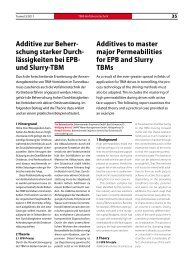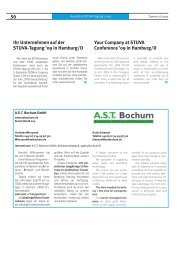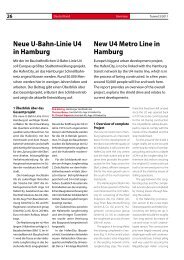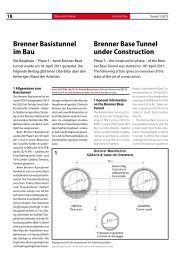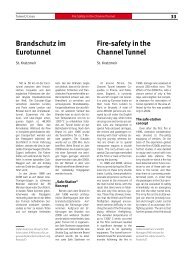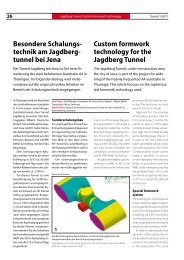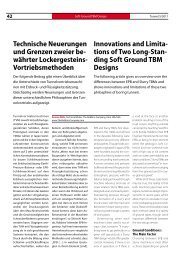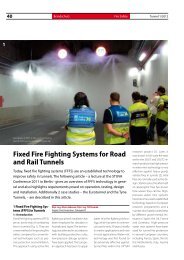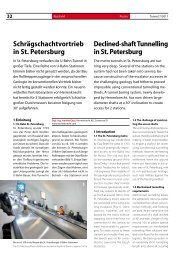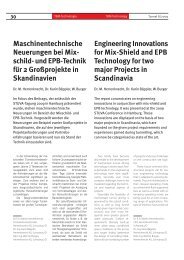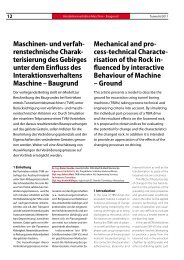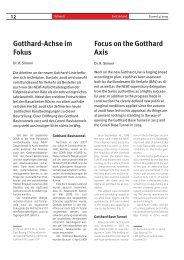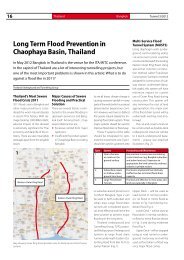Gotthard-Basistunnel: Stand der Arbeiten Gotthard Base Tunnel ...
Gotthard-Basistunnel: Stand der Arbeiten Gotthard Base Tunnel ...
Gotthard-Basistunnel: Stand der Arbeiten Gotthard Base Tunnel ...
Sie wollen auch ein ePaper? Erhöhen Sie die Reichweite Ihrer Titel.
YUMPU macht aus Druck-PDFs automatisch weboptimierte ePaper, die Google liebt.
<strong>Tunnel</strong> 04/2010 GBT: Stage reached by work<br />
13<br />
<strong>Gotthard</strong>-<strong>Basistunnel</strong>:<br />
<strong>Stand</strong> <strong>der</strong> <strong>Arbeiten</strong><br />
Dr. R. Simoni<br />
Ende März 2010 waren vom insgesamt 151,8 km<br />
langen <strong>Tunnel</strong>system des <strong>Gotthard</strong>-<strong>Basistunnel</strong>s<br />
144,8 km o<strong>der</strong> 95,4 % ausgebrochen.<br />
Bis zum Hauptdurchschlag zwischen Sedrun<br />
und Faido, <strong>der</strong> am 15. Oktober 2010 stattfindet,<br />
fehlen nur noch etwa 2,5 km. Der folgende<br />
Beitrag gibt einen Überblick über den <strong>Stand</strong><br />
<strong>der</strong> <strong>Arbeiten</strong>.<br />
<strong>Gotthard</strong> <strong>Base</strong> <strong>Tunnel</strong>:<br />
Stage reached by Work<br />
Dr. R. Simoni<br />
At the end of March 2010, a total of 144.8 km or<br />
95.4 % of the altogether 151.8 km long tunnel<br />
system for the <strong>Gotthard</strong> <strong>Base</strong> <strong>Tunnel</strong> had been<br />
excavated. Only some 2.5 km is still missing<br />
until the main breakthrough between Sedrun<br />
and Faido takes place on October 15, 2010. The<br />
following report provides an overview on the<br />
stage reached by work.<br />
Parallel zum Vortrieb kamen<br />
auf allen Baustellen die Rohbau-<br />
Ausrüstung und die Betonarbeiten<br />
für den Innenausbau<br />
voran. Ende 2009 waren<br />
85 von 176 Querschlägen ausgerüstet<br />
und etwa 9427 m<br />
Innengewölbe betoniert. Aus<br />
heutiger Sicht steht <strong>der</strong> planmäßigen<br />
Eröffnung des<br />
<strong>Gotthard</strong>-<strong>Basistunnel</strong>s im Jahr<br />
2017 nichts im Weg (Bild 1).<br />
Offene Strecke<br />
<strong>Gotthard</strong> Nord<br />
Die offene Zufahrtsstrecke<br />
zum <strong>Gotthard</strong>-<strong>Basistunnel</strong> umfasst<br />
neben dem Bahntrassee<br />
zahlreiche Kunstbauten. Nicht<br />
weniger als 6 Unterführungen<br />
mit bis zu 75 m Länge, 5<br />
Brückenbauwerke mit bis zu 21<br />
m Spannweite und eine Vielzahl<br />
von Durchlässen und Stützmauern<br />
sind zu erstellen. Es<br />
wird permanent gleichzeitig an<br />
verschiedenen Projektteilen gearbeitet.<br />
Dr. Renzo Simoni, Dr. sc. techn.,<br />
Bauing. ETH, Vorsitzen<strong>der</strong> <strong>der</strong><br />
Geschäftsleitung, AlpTransit<br />
<strong>Gotthard</strong> AG, Luzern/CH<br />
Teilabschnitt Erstfeld<br />
Der <strong>Gotthard</strong>-<strong>Basistunnel</strong><br />
verläuft im Abschnitt Erstfeld<br />
in einer rd. 7,2 km langen<br />
Felsstrecke in 2 Einspurröhren,<br />
die mit je einer <strong>Tunnel</strong>bohrmaschine<br />
mit einem Ausbruchdurchmesser<br />
von 9,58 m aufgefahren<br />
wurden. Mit dem<br />
Durchschlag in <strong>der</strong> Oströhre<br />
am 16. Juni 2009 und exakt<br />
3 Monate später in <strong>der</strong><br />
Weströhre war <strong>der</strong> Vortrieb in<br />
den beiden Röhren zwischen<br />
dem Portal Erstfeld und <strong>der</strong><br />
Losgrenze Amsteg deutlich früher<br />
als geplant abgeschlossen.<br />
Nach Vortriebsende folgten jeweils<br />
die unterirdische Demontage<br />
und <strong>der</strong> Abtransport <strong>der</strong><br />
<strong>Tunnel</strong>bohrmaschinen durch<br />
die ausgebrochenen <strong>Tunnel</strong>röhren.<br />
Vortrieb bergmännischer<br />
<strong>Tunnel</strong><br />
Die beiden <strong>Tunnel</strong>bohrmaschinen<br />
erreichten bis zu<br />
den Durchschlägen hervorragende<br />
Vortriebsleistungen. In<br />
<strong>der</strong> Oströhre erreichte die<br />
Arbeitsgemeinschaft <strong>Gotthard</strong>-<br />
<strong>Basistunnel</strong> Nord Los 151<br />
Erstfeld (AGN Los 151) eine<br />
The roughwork execution<br />
and the concreting operations<br />
for the inner lining also progressed<br />
parallel to the drive at<br />
all construction sites. At the end<br />
of 2009, 85 from 176 cross-passages<br />
had been furnished and<br />
roughly 9,427 m of inner vault<br />
concreted. Seen from the<br />
present viewpoint nothing<br />
stands in the way of the <strong>Gotthard</strong><br />
<strong>Base</strong> <strong>Tunnel</strong> being opened in<br />
2017 according to schedule<br />
(Fig. 1).<br />
<strong>Gotthard</strong> North<br />
open Route<br />
The open access route to the<br />
<strong>Gotthard</strong> <strong>Base</strong> <strong>Tunnel</strong> includes<br />
many engineering structures in<br />
addition to the rail line. No less<br />
than 6 un<strong>der</strong>passages of up to<br />
75 m in length, 5 bridges with<br />
spans extending up to 21 m and<br />
a large number of passages and<br />
supporting walls have to be<br />
produced. Work is constantly<br />
progressing on various parts of<br />
the project.<br />
Erstfeld Part-Section<br />
The <strong>Gotthard</strong> <strong>Base</strong> <strong>Tunnel</strong><br />
runs in a roughly 7.2 km long<br />
rock section in 2 single-track<br />
bores in the Erstfeld part-section,<br />
which were each driven by<br />
a tunnel boring machine of<br />
9.58 m diameter. Driving in the<br />
2 tubes was completed consi<strong>der</strong>ably<br />
earlier than scheduled<br />
between the Erstfeld portal and<br />
the Amsteg section boundary<br />
with the breakthrough accomplished<br />
in the eastern bore on<br />
June 16, 2009 and exactly<br />
3 months later in the western<br />
one. After concluding the excavation<br />
in each case the tunnel<br />
boring machines had to be dismantled<br />
un<strong>der</strong>ground and retrieved<br />
through the excavated<br />
tunnel bores.<br />
Driving <strong>Tunnel</strong>s by<br />
Mining Means<br />
The 2 tunnel boring machines<br />
attained outstanding<br />
rates of advance until the breakthroughs.<br />
In the eastern bore<br />
the JV <strong>Gotthard</strong>-<strong>Basistunnel</strong><br />
Dr. Renzo Simoni, CEO AlpTransit<br />
<strong>Gotthard</strong> AG, Lucerne/CH
14 Schweiz Switzerland<br />
<strong>Tunnel</strong> 04/2010<br />
1 Überblick über den <strong>Stand</strong> von Norden nach Süden<br />
1 Overview of progress from north to south<br />
durchschnittliche Leistung pro<br />
Arbeitstag von 18,27 m. Mit<br />
einem vermessungstechnischen<br />
Durchschlagfehler von 14 mm<br />
quer zur <strong>Tunnel</strong>achse und 5 mm<br />
in <strong>der</strong> Höhe wurde auch das Ziel<br />
eines minimalen Durchschlagfehlers<br />
erreicht.<br />
In <strong>der</strong> Weströhre resultierte<br />
eine durchschnittliche Vortriebsleistung<br />
von 16,27 m/AT. Mit<br />
56 m gefräster und gesicherter<br />
<strong>Tunnel</strong>röhre in 24 Stunden war<br />
die <strong>Tunnel</strong>bohrmaschine „Gabi<br />
II“ am 19. Juli 2009 auf (Welt)-<br />
Rekordfahrt. Auch <strong>der</strong> zweite<br />
Durchschlag erfolgte mit höchster<br />
Präzision. Die Abweichung<br />
quer zur <strong>Tunnel</strong>achse betrug nur<br />
gerade 9 mm, in <strong>der</strong> Höhe 7 mm.<br />
Rohbau <strong>Tunnel</strong><br />
Erstfeld<br />
Dem Vortrieb folgte <strong>der</strong><br />
Einbau <strong>der</strong> Sohle und <strong>der</strong> darin<br />
einbetonierten Schmutzwasserleitung.<br />
Parallel dazu erfolgte<br />
<strong>der</strong> Ausbruch <strong>der</strong> 23<br />
Querschläge. Mittlerweile ist<br />
<strong>der</strong> Innenausbau bei 21 davon<br />
abgeschlossen. Die 2 verbleibenden<br />
Querschläge werden für<br />
logistische Zwecke im Zusammenhang<br />
mit dem Ausbruch<br />
und dem Ausbau <strong>der</strong> Verzweigungsbauwerke<br />
benötigt.<br />
In beiden Röhren sind die<br />
<strong>Arbeiten</strong> am Fundament für die<br />
Gewölbeschalung, dem Kicker,<br />
im Gang. In <strong>der</strong> Oströhre waren<br />
Ende Februar 2010 3826 m<br />
und damit mehr als 50 % betoniert.<br />
In <strong>der</strong> Weströhre sind<br />
5370 m (rd. 75 %) erstellt und<br />
bereit für die folgenden<br />
Gewölbearbeiten.<br />
Nach dem Transport <strong>der</strong><br />
Schalungseinheiten (bestehend<br />
aus Abdichtungswagen, Bewehrungswagen,<br />
Gewölbeschalung<br />
und Nachbehandlungswagen)<br />
Nord contract section 151 (AGN<br />
Los 151) arrived at an average<br />
rate of 18.27 m per working day.<br />
The objective of a minimal<br />
breakthrough error was also<br />
achieved with a technical breakthrough<br />
error of 14 mm measured<br />
crosswise to the tunnel<br />
axis and 5 mm regarding the<br />
height.<br />
In the western bore an<br />
average rate of advance of<br />
16.27 m per working day was<br />
achieved. With 56 m of cut and<br />
secured tunnel bore in 24 h the<br />
tunnel boring machine “Gabi II”<br />
accomplished a (world) record<br />
passage on July 19, 2009. The<br />
second breakthrough also took<br />
place with the utmost precision.<br />
The deviation crosswise to the<br />
tunnel axis only amounted to<br />
9 mm in the straight and 7 mm<br />
regarding height.<br />
Erstfeld <strong>Tunnel</strong><br />
Roughwork<br />
The excavation was followed<br />
by installation of the invert with<br />
the waste water pipe being concreted<br />
into it. The 23 cross-passages<br />
were excavated parallel to<br />
these operations. In the interim<br />
the inner lining of 21 of them<br />
has been concluded. The 2 remaining<br />
cross-passages are required<br />
for logistical purposes in<br />
conjunction with excavating<br />
and securing the fork structures.<br />
In both bores work on the<br />
foundations for the vault formwork,<br />
the kicker, is in progress. In<br />
the eastern bore 3,826 m accounting<br />
for more than 50 %<br />
had been concreted at the end<br />
of February 2010. 5,370 m (some<br />
75 %) had been concreted in<br />
the western bore and made<br />
ready for the subsequent vault<br />
operations.
<strong>Tunnel</strong> 04/2010 GBT: <strong>Stand</strong> <strong>der</strong> <strong>Arbeiten</strong><br />
15<br />
von Amsteg nach Erstfeld im<br />
Januar 2010 konnten in <strong>der</strong><br />
Oströhre im Februar 2010<br />
die Gewölbearbeiten beginnen<br />
(Bild 2).<br />
Die innovative Lösung mit<br />
Banketten aus vorfabrizierten<br />
Elementen hat sich in Amsteg<br />
bestens bewährt und kommt<br />
nun auch in Erstfeld anstelle <strong>der</strong><br />
Ortbetonbauweise zum Einsatz.<br />
Mit den im Betonwerk vorfabrizierten<br />
Elementen kann eine<br />
höhere Verlegegenauigkeit <strong>der</strong><br />
im Bankett eingelegten Kabelschutzrohre<br />
erreicht werden.<br />
Wasseranfall<br />
Wie sich bereits im vergangenen<br />
Jahr gezeigt hat, ist <strong>der</strong><br />
Bergwasseranfall im Teilabschnitt<br />
Erstfeld wesentlich höher<br />
als prognostiziert. Die anfallenden<br />
Bergwassermengen 2 Concreting the inner<br />
2 Betonierung des Innengewölbes<br />
vault
16 Schweiz Switzerland<br />
<strong>Tunnel</strong> 04/2010<br />
3 Schema Ausbruch und Aufweitung <strong>der</strong> Verzweigungsbauwerke<br />
3 Set-up of excavation and enlargement of the fork structures<br />
nahmen seit dem Erreichen des<br />
Spitzenwertes von rd. 465 l/s<br />
im Juli 2009 wie<strong>der</strong> deutlich<br />
ab. Im Winterhalbjahr flossen<br />
rd. 220 l/s aus dem <strong>Tunnel</strong>. Im<br />
Frühjahr/Sommer 2010 ist mit<br />
einem erneuten Anstieg zu rechnen.<br />
Um die erwarteten großen<br />
Wassermengen im Sommer<br />
2010 bewältigen zu können,<br />
wurde die Wasserbehandlungsanlage<br />
um weitere Behandlungsstraßen<br />
erweitert. Es steht eine<br />
Kapazität von 400 l/s zur<br />
Verfügung, zusätzlich können<br />
100 l/s über eine Notbehandlung<br />
geführt werden. Im Sachplan<br />
AlpTransit des Bundes ist die<br />
unterirdische Fortsetzung des<br />
<strong>Tunnel</strong>s in Richtung Axen, Uri<br />
Berg Lang Axen (UBLA) genannt,<br />
festgeschrieben.<br />
vortrieb aufgefahren. Anfangs<br />
entspricht die Ausbruchfläche<br />
jener <strong>der</strong> Einspurtunnel, danach<br />
nimmt sie auf einer Länge von<br />
400 m kontinuierlich zu und beträgt<br />
bei einem Achsabstand<br />
<strong>der</strong> Gleise von 12 m im<br />
Maximum rd. 200 m 2 . Die Dicke<br />
des Felspfeilers zwischen dem<br />
Einspurtunnel und <strong>der</strong> abzweigenden<br />
Röhre beträgt an dieser<br />
Stelle 3 m, die Spannweite des<br />
Ausbruchs rd. 22 m. Im Frühling<br />
2009 begann <strong>der</strong> Ausbruch des<br />
After the formwork units<br />
(comprising sealing car, reinforcement<br />
car, vault formwork<br />
and curing car) were transported<br />
from Amsteg to Erstfeld in<br />
January 2010, work on the vault<br />
started in the eastern bore in<br />
February 2010.<br />
The innovative solution with<br />
verges consisting of prefabricated<br />
elements proved itself extremely<br />
well in Amsteg and was<br />
applied in Erstfeld instead of the<br />
in situ concrete construction<br />
method. Thanks to the elements<br />
precast in the concrete plant a<br />
higher degree of accuracy for<br />
laying the cable protection<br />
pipes in the verges can be<br />
attained.<br />
Water Incidence<br />
As was revealed last year the<br />
incidence of un<strong>der</strong>ground water<br />
in the Erstfeld part-section is<br />
consi<strong>der</strong>ably higher than forecast.<br />
The ingressing amounts of<br />
Verzweigungsbauwerke<br />
Als Vorinvestition und um<br />
ungünstige bau- und bahnbetriebliche<br />
Randbedingungen für<br />
eine spätere Realisierung („Uri<br />
Berg lang Axen) zu vermeiden,<br />
werden die unterirdischen<br />
Verzweigungsbauwerke bereits<br />
jetzt ausgebrochen.<br />
Die rd. 400 m langen<br />
Kavernen sind trompetenförmig<br />
und werden im Spreng-<br />
4 Aufweitung Verzweigungsbauwerk<br />
4 Fork structure enlargement
<strong>Tunnel</strong> 04/2010<br />
Stage reached by work<br />
Verzweigungsbauwerks Ost, im<br />
Juli 2009 startete auch <strong>der</strong><br />
Vortrieb <strong>der</strong> Verzweigung in<br />
<strong>der</strong> Weströhre. Die Ausbrucharbeiten<br />
werden in mehreren<br />
Etappen ausgeführt (Bild 3).<br />
Zuerst muss <strong>der</strong> definitive<br />
Felspfeiler (0) gesichert werden.<br />
Der Zugangsstollen zur abzweigenden<br />
Röhre (1) wird gesprengt<br />
und im Folgenden <strong>der</strong><br />
für die Ausbrucharbeiten <strong>der</strong><br />
abzweigenden Röhre benötigte<br />
Dienststollen (2) aufgefahren.<br />
Nun kann <strong>der</strong> Sprengvortrieb<br />
<strong>der</strong> abzweigenden Röhre (3)<br />
beginnen. Der Vortrieb <strong>der</strong><br />
140 m (bzw. in <strong>der</strong> Verzweigung<br />
West 180 m) langen Röhre unterteilt<br />
sich in Ausbruch von<br />
Kalotte und von Strosse/Sohle.<br />
Im Anschluss folgt die Aufweitung<br />
<strong>der</strong> Verzweigung vom<br />
Einspurtunnel aus (5). Die<br />
Ausweitung von First und<br />
Parament geschieht ebenfalls in<br />
Etappen. Schliesslich erfolgt <strong>der</strong><br />
weitere Ausbruch <strong>der</strong> restlichen<br />
Bereiche (6). Der hier nicht aufgezeigte<br />
Arbeitsschritt (4) betrifft<br />
den Ausbruch von Nischen<br />
im Weichenbereich.<br />
Per Ende Februar 2010 waren<br />
336 m von 382 m <strong>der</strong><br />
Aufweitung Ost ausgebrochen<br />
und gesichert. Bis Ende April<br />
2010 waren die Aufweitungsarbeiten<br />
abgeschlossen. Im Verzweigungsbauwerk<br />
West sind<br />
bis dato 90 m von 404 m ausgebrochen<br />
und gesichert. Die<br />
<strong>Arbeiten</strong> werden bis Juni 2010<br />
abgeschlossen sein (Bild 4).<br />
Die beiden Verzweigungskavernen<br />
werden zweischalig<br />
mit einer Ausbruchsicherung<br />
bestehend aus Systemankerung<br />
(Reibrohranker bzw. Mörtelanker)<br />
und einer bewehrten<br />
Spritzbetonschale, einer Abdichtung<br />
und <strong>der</strong> Innenschale aus<br />
Ortbeton ausgeführt. Die Dicke<br />
<strong>der</strong> bewehrten Ortbetonschale<br />
nimmt mit zunehmen<strong>der</strong><br />
Spannweite von 30 cm auf<br />
maximal 45 cm zu. Im Verzweigungsbauwerk<br />
Ost beginnen<br />
die Gewölbearbeiten im Juli<br />
un<strong>der</strong>ground water have diminished<br />
substantially since the<br />
peak value of roughly 465 l/s<br />
was attained in July 2009.<br />
During the winter half year<br />
some 220 l/s flowed out of the<br />
tunnel. A new increase has to be<br />
reckoned with during spring/<br />
summer 2010. In or<strong>der</strong> to be<br />
able to cope with the expected<br />
large amounts of water in summer<br />
2010, the water treatment<br />
plant was extended by extra<br />
treatment channels. A capacity<br />
of 400 l/s is available with the<br />
possibility of handling an additional<br />
100 l/s via an emergency<br />
treatment channel. The un<strong>der</strong>ground<br />
continuation of the<br />
<strong>Tunnel</strong> in the direction of Axen<br />
(Uri Berg Lang Axen (UBLA)) is<br />
laid down in the government’s<br />
AlpTransit sectoral plan.<br />
Fork Structure<br />
As a prior investment and to<br />
avoid unfavourable constructional<br />
and rail operational general<br />
conditions for any subsequent<br />
task (“Uri Berg Lang<br />
Axen”), the un<strong>der</strong>ground fork<br />
structures are currently being<br />
excavated.<br />
The roughly 400 m long<br />
chambers are trumpet-shaped<br />
and are driven via drill+blast.<br />
Initially the excavated area<br />
equals that of the single-track<br />
tunnels subsequently it is gradually<br />
increased over a length of<br />
400 m and amounts to a maximum<br />
of some 200 m2 given a<br />
12 m track centre distance. At<br />
this point the thickness of the<br />
rock pillar between the singletrack<br />
tunnel and the forking<br />
bores amounts to 3 m, the span<br />
width of the excavation some<br />
22 m. Work on excavating the<br />
fork structure East began in<br />
spring 2009, while driving the<br />
fork on the western bore started<br />
in July 2009. Excavation operations<br />
are being un<strong>der</strong>taken in a<br />
number of stages (Fig. 3).<br />
First of all the definitive rock<br />
pillar (0) must be secured. The
18 Schweiz Switzerland<br />
<strong>Tunnel</strong> 04/2010<br />
2010, im Westen im November<br />
2010. Der Innenausbau <strong>der</strong> abzweigenden<br />
Röhren beschränkt<br />
sich auf eine einschalige<br />
Spritzbetonschale, einzig die<br />
ersten 10 m entsprechen dem<br />
Profil <strong>der</strong> Einspurtunnel und<br />
sind mit einem Ortbeton-<br />
Innengewölbe versehen.<br />
Tagbautunnel<br />
Die ersten 600 m des<br />
<strong>Gotthard</strong>-<strong>Basistunnel</strong>s entstehen<br />
im Tagbau. Die <strong>Arbeiten</strong><br />
wurden im April 2008 aufgenommen.<br />
In <strong>der</strong> Endgestaltung<br />
werden die beiden Tagbautunnelröhren<br />
bis zu 14 m hoch<br />
mit Ausbruchmaterial aus dem<br />
<strong>Tunnel</strong> überschüttet. Ende<br />
Februar 2010 waren 420 m<br />
<strong>der</strong> Oströhre und 250 m <strong>der</strong><br />
Weströhre fertig betoniert. Für<br />
die Erstellung <strong>der</strong> beiden<br />
Tagbautunnelröhren sind 5 verschiedene<br />
Profiltypen notwendig.<br />
Beginnend mit dem im<br />
Endzustand sichtbaren polygonalen<br />
Profil im Portalbereich<br />
Erstfeld werden die beiden<br />
<strong>Tunnel</strong>röhren direkt nebeneinan<strong>der</strong><br />
geführt. Im Anschluss<br />
werden die beiden Röhren getrennt<br />
geführt und <strong>der</strong> Achsabstand<br />
<strong>der</strong> beiden <strong>Tunnel</strong>röhren<br />
nimmt Richtung Süden von rd.<br />
8 m auf 13 m zu. Im Innern <strong>der</strong><br />
<strong>Tunnel</strong>röhre geht das Profil<br />
vom polygonalen in ein hufeisenförmiges<br />
Profil über. Im<br />
Übergangsbereich vom Tagbautunnel<br />
zum bergmännischen<br />
<strong>Tunnel</strong> werden mit <strong>der</strong><br />
Erstellung <strong>der</strong> Kragplatte Ost<br />
im Sommer 2010 die Voraussetzungen<br />
für den Zusammenschluss<br />
<strong>der</strong> beiden <strong>Tunnel</strong>profile<br />
geschaffen. Im Winter<br />
2011 werden die Vorbereitungen<br />
für die Verbindung <strong>der</strong><br />
Röhre West getroffen (Bild 5).<br />
Teilabschnitt Amsteg<br />
Im Verlauf des Jahres 2009<br />
wurde das Innengewölbe <strong>der</strong><br />
5 Tagbautunnel Erstfeld<br />
5 Erstfeld cut-and-cover tunnel<br />
access tunnel to the forking<br />
bore (1) is blasted and the service<br />
tunnel (2) subsequently required<br />
for the excavation operations<br />
driven. Now the drill+blast<br />
operations for the forking bore<br />
(3) can be commenced. Driving<br />
the 140 m (resp. 180 m in the<br />
beiden Röhren fertig gestellt.<br />
Zuletzt war in <strong>der</strong> Oströhre <strong>der</strong><br />
Einbau des Gewölbes im Bereich<br />
Startröhre, Montagekaverne<br />
und Speisepunkt erfolgt, während<br />
in <strong>der</strong> Weströhre <strong>der</strong><br />
Banketteinbau lief. Im 2. Halbjahr<br />
2009 wurden die Betonwestern<br />
fork) long bore is divided<br />
up into excavating the crown<br />
and bench/invert. Then the fork<br />
is extended from the singletrack<br />
tunnel (5). The roof and<br />
walls are also enlarged in stages.<br />
Finally the remaining sectors (6)<br />
are excavated. The working
<strong>Tunnel</strong> 04/2010 GBT: <strong>Stand</strong> <strong>der</strong> <strong>Arbeiten</strong><br />
19<br />
arbeiten <strong>der</strong> Querschlagabschlusswände<br />
abgeschlossen<br />
und die Querschläge, als Abschluss<br />
zu den beiden <strong>Tunnel</strong>röhren,<br />
mit Querschlagtüren<br />
ausgerüstet. Die Querschläge<br />
wurden mit Lüftungssystemen<br />
und Doppelböden versehen. Die<br />
Konstruktion <strong>der</strong> Doppelböden<br />
besteht aus einer Unterkonstruktion<br />
aus Edelstahl,<br />
einem Gitterrost aus glasfaserverstärktem<br />
Kunststoff, sowie<br />
faserbewehrten, unbefestigten<br />
Bodenplatten.<br />
Abnahme<br />
röhren südlich <strong>der</strong> Montagekavernen<br />
bis zur Losgrenze des<br />
Teilabschnitts Sedrun, sowie<br />
des Kabelstollens bis zum<br />
Kraftwerk Amsteg statt. Mit<br />
<strong>der</strong> Abnahme wurde das Werk<br />
– und damit auch Nutzen und<br />
Gefahr – in die Verantwortung<br />
des Bauherrn übergeben. Seit<br />
dem 15. Januar 2010 sind die<br />
Einspurröhren Ost und West,<br />
sowie die Querschläge in <strong>der</strong><br />
Obhut des Bahntechnikunternehmers.<br />
Im Zugangsstollen und im<br />
Fußpunkt Amsteg werden noch<br />
<strong>Arbeiten</strong> ausgeführt. Insbeson<strong>der</strong>e<br />
im Kreuzungsbereich des<br />
Baustollens mit den beiden<br />
Einspurtunneln und im Speisepunkt<br />
sind aufwändige Betonarbeiten<br />
nötig. Diese werden<br />
bis Ende 2011 abgeschlossen<br />
sein.<br />
Der Rohbau <strong>der</strong> rd. 11 km<br />
langen <strong>Tunnel</strong>röhren zwischen<br />
Amsteg und Sedrun war termingemäß<br />
fertig und ist bereit<br />
für den Einbau <strong>der</strong> Bahntechnik.<br />
Am 9. Dezember 2009 fand die<br />
Abnahme <strong>der</strong> beiden <strong>Tunnel</strong>stage<br />
not shown here relates to<br />
excavating recesses in the<br />
points area.<br />
As at the end of February<br />
2010, 336 of 382 m for the enlargement<br />
East had been driven<br />
and secured. The enlargement<br />
operations were concluded by<br />
the end of April 2010. In the fork<br />
structure West so far 90 of 404 m<br />
has been excavated and supported.<br />
This work will be concluded<br />
in June 2010 (Fig. 4).<br />
The 2 fork chambers are produced<br />
with a double shell with<br />
an excavation support constituting<br />
an anchorage system<br />
(friction anchors or mortar anchors)<br />
and a reinforced shotcrete<br />
shell, a seal and an in situ<br />
concrete inner shell. The thickness<br />
of the reinforced in situ<br />
concrete shell increases in keeping<br />
with the span width from<br />
30 to a maximum of 45 cm. In<br />
the fork structure East vault operations<br />
are due to start in July<br />
2010 and in November 2010 in<br />
the western one. The inner lining<br />
of the forking bores is limited<br />
to a monocoque shotcrete<br />
shell, however, the first 10 m<br />
correspond with the profile of<br />
the single-track tunnels and are<br />
provided with an in situ concrete<br />
inner vault.<br />
Cut-and-Cover <strong>Tunnel</strong>s<br />
The first 600 m of the<br />
<strong>Gotthard</strong> <strong>Base</strong> <strong>Tunnel</strong> is produced<br />
by cut-and-cover.<br />
Operations began in April 2008.<br />
In their final state, the 2 cut-andcover<br />
tunnel sections will be<br />
covered up to 14 m high with<br />
material obtained from the<br />
<strong>Tunnel</strong>. At the end of February<br />
2010, 420 m of the eastern bore<br />
and 250 m of the western one
20 Schweiz Switzerland<br />
<strong>Tunnel</strong> 04/2010<br />
completed. To round things off<br />
the vault in the starting pipe<br />
section, assembly chamber and<br />
fee<strong>der</strong> point was installed in the<br />
eastern bore whilst the verge<br />
was produced in the western<br />
one. In the second half of 2009<br />
the concreting operations for<br />
the cross-passage closing walls<br />
were completed and the crosspassages,<br />
fitted with doors as<br />
closures to the 2 tunnel bores.<br />
The cross-passages were provided<br />
with ventilation systems<br />
and raised floors. These floors<br />
consist of a sub-structure made<br />
of stainless steel, a lattice grate<br />
made of glass fibre reinforced<br />
plastic as well as fibre-reinforced,<br />
unfortified floor slabs.<br />
Acceptance<br />
6 Deponie Claus Surrein<br />
6 Claus Surrein dump<br />
Teilabschnitt Sedrun<br />
Nach den ausgedehnten<br />
Störzonen erreichten die<br />
Südvortriebe im Frühsommer<br />
2009 die geologisch günstige<br />
Formation <strong>der</strong> Paradiesgneise.<br />
Es resultierten durchschnittliche<br />
Auffahrleistungen von<br />
4 m/Tag, bei maximalen Leistungen<br />
von bis zu 7 m/Tag. Am<br />
20. Oktober erreichte <strong>der</strong><br />
Vortrieb in <strong>der</strong> Weströhre Süd<br />
<strong>Tunnel</strong>kilometer 226.308 und<br />
damit die ursprünglich vertraglich<br />
vereinbarte Losgrenze (inkl.<br />
<strong>der</strong> Option von 1 km). Zur<br />
Terminsicherung hatte sich die<br />
ATG im Jahr 2008 entschieden,<br />
die Losgrenze in Richtung Faido<br />
zu verschieben.<br />
Neue Deponie Claus<br />
Surrein<br />
Die Verschiebung <strong>der</strong><br />
Losgrenze von Sedrun in<br />
Richtung Faido hat den Anfall<br />
von bis zu weiteren 750.000 t<br />
Ausbruchmaterial zur Folge und<br />
erfor<strong>der</strong>te eine Anpassung des<br />
Bewirtschaftungskonzepts, da<br />
die bisherigen Deponien (Val<br />
Bugnei, Val Bugnei Ost) erschöpft<br />
waren. In <strong>der</strong> ersten<br />
Jahreshälfte 2009 wurden die<br />
Installationen für die Ablagerung<br />
Claus Surrein erstellt. Diese beinhalten<br />
die För<strong>der</strong>bandanlage<br />
(För<strong>der</strong>band über die Cavorgiabrücke,<br />
Verteilbän<strong>der</strong> im<br />
Deponiebereich, Verteilstationen<br />
und Übergabetürme).<br />
Termingerecht konnte mit <strong>der</strong><br />
Deponierung von Ausbruchmaterial<br />
am 1. Oktober 2009<br />
begonnen werden. Bis Ende<br />
März 2010 wurden 143.000 t<br />
Ausbruchmaterial und Schlamm<br />
abgelagert (Bild 6).<br />
<strong>Tunnel</strong>vortrieb Süd<br />
Im Oktober 2009 ereignete<br />
sich in <strong>der</strong> Oströhre bei km<br />
126.252,5 ein Nie<strong>der</strong>bruch. Im<br />
Laufe <strong>der</strong> Schutter-/Sicherungsmaßnahmen<br />
fand eine zunehmende<br />
Vernässung des östlichen<br />
First und Paramentbereichs<br />
statt. Die Vernässung<br />
des kakiritisierten Gesteins<br />
führte zu einer beginnenden<br />
Kaminbildung, welche auch<br />
had been completely concreted.<br />
Five different types of profile<br />
are needed to produce the 2<br />
cut-and-cover tunnel sections.<br />
The 2 tunnel bores run directly<br />
parallel to one another<br />
starting with the polygonal profile<br />
at the Erstfeld portal zone,<br />
which is visible in the final state<br />
of the <strong>Tunnel</strong>. Then the 2 bores<br />
run separately and the centre<br />
distance between the 2 tunnel<br />
bores increases from some 8 to<br />
13 m towards the south. Inside<br />
the tunnel bores, the cross-section<br />
changes from a polygon to<br />
a horse-shoe shape. In the transition<br />
section from the cut-andcover<br />
to the trenchless tunnel,<br />
the cantilever plate East is to be<br />
produced by summer 2010 providing<br />
the prior conditions for<br />
interconnecting the 2 tunnel<br />
profiles. The preparations for<br />
the western bore connection<br />
will be un<strong>der</strong>taken in winter<br />
2011 (Fig. 5).<br />
Amsteg Part-Section<br />
In the course of 2009 the inner<br />
vault for the 2 bores was<br />
The roughwork of the approx.<br />
11 km long tunnel bores<br />
between Amsteg and Sedrun<br />
was finished according to<br />
schedule and is ready for installing<br />
the rail technology. On<br />
December 9, 2009 the 2 tunnel<br />
bores to the south of the assembly<br />
chambers up to the section<br />
boundary of the Sedrun partsection<br />
as well as the cable tunnel<br />
up to the Amsteg power station<br />
were approved. Through<br />
acceptance the structure – and<br />
in turn usage and danger –<br />
passed over into the responsibility<br />
of the client. Since January<br />
15, 2010 the single-track tunnels<br />
East and West as well as the<br />
cross-sections have become<br />
the responsibility of the rail<br />
technology contractor.<br />
Work is still progressing in<br />
the access tunnel and at the<br />
Amsteg bottom point. Extensive<br />
concreting operations are required<br />
particularly at the intersection<br />
area of the construction<br />
tunnel with the 2 single-track<br />
tunnels and at the fee<strong>der</strong> point.<br />
These are to be concluded by<br />
the end of 2011.
<strong>Tunnel</strong> 04/2010<br />
Stage reached by work<br />
durch Spritzbetonauftrag nicht<br />
mehr gestoppt werden konnte.<br />
Der Nachbruch erfolgte sowohl<br />
aufwärts wie auch rückwärts.<br />
Das Bergwasser muss durch die<br />
Auflockerung den Weg vom<br />
Umgebungsgestein in den ansonsten<br />
relativ undurchlässigen<br />
kakiritisierten Bereich gefunden<br />
haben (Bild 7).<br />
Innenausbau<br />
Große Fortschritte machte<br />
im Teilabschnitt Sedrun auch<br />
<strong>der</strong> Innenausbau. Nach <strong>der</strong> erfolgreichen<br />
technischen Prüfung<br />
von km 120.200/220.200 bis<br />
Losgrenze Nord gingen im<br />
Oktober die beiden <strong>Tunnel</strong>röhren<br />
nördlich <strong>der</strong> Multifunktionsstelle<br />
termingerecht und unter Einhaltung<br />
des vorgesehenen Kostenrahmens<br />
in die Obhut <strong>der</strong><br />
ATG über. Am 15. Januar 2010<br />
konnte dieser Abschnitt dem<br />
Nachfolgeunternehmer Transtec<br />
für den Einbau <strong>der</strong> Bahntechnik<br />
übergeben werden.<br />
Teilabschnitt Faido<br />
Beide <strong>Tunnel</strong>bohrmaschinen<br />
haben die Piora-Mulde problemlos<br />
durchfahren (tunnel<br />
4/2009, Erfolgreiche Durchörterung<br />
<strong>der</strong> Piora-Mulde im<br />
Teilabschnitt Faido). Der Vortrieb<br />
in den folgenden Medelser-<br />
Graniten stellte die Maschinen<br />
bezüglich Verschleiß von Bohrwerkzeugen<br />
und Bohrkopf vor<br />
hohe Herausfor<strong>der</strong>ungen. Rund<br />
alle 1000 m war eine Bohrkopfrevision<br />
nötig. Bautechnisch<br />
zeigten sich keine allzu großen<br />
Überraschungen. Vereinzelt<br />
wurden leichte Bergschläge registriert.<br />
Der Initialwasseranfall<br />
lag abschnittweise bei 20 l/sec,<br />
insgesamt bei rd. 45 l/sec. Es<br />
resultierten durchschnittliche<br />
Vortriebsleistungen von 280 bis<br />
540 m/Monat. Der Intrusionskörper<br />
des Medelser-Granits<br />
war aber mit 4,5 km deutlich<br />
länger als die prognostizierten<br />
2 km.<br />
Sedrun Part-Section<br />
Following extensive fault<br />
zones the southern drives<br />
reached the geologically favourable<br />
Paradies gneiss formation<br />
in early summer 2009. The<br />
outcome was average rates of<br />
advance amounting to 4 m/d<br />
given maximum rates of up to<br />
7 m/d. On October 20, the drive<br />
reached tunnel kilometre<br />
226.308 in the western bore<br />
South and thus the originally<br />
contractually agreed section<br />
boundary (incl. the 1 km option).<br />
In 2008, the ATG decided<br />
to relocate the section boundary<br />
towards Faido in or<strong>der</strong> to adhere<br />
to deadlines.<br />
New Claus Surrein<br />
Dump<br />
The relocation of the Sedrun<br />
section boundary in the direction<br />
of Faido resulted in the accumulation<br />
of a further 750,000 t<br />
of spoil so that the material<br />
management concept had to<br />
be adjusted as the capacity of<br />
the existing dumps (Val Bugnei,<br />
Val Bugnei East) had been exhausted.<br />
During the first half of<br />
2009, the installations for the<br />
Claus Surrein dump were set up.<br />
These include the belt conveyor<br />
system (conveyor over the<br />
Cavorgia bridge, distributor<br />
belts in the dumping area, distributor<br />
stations and transfer<br />
towers). It was possible to start<br />
dumping the spoil on October<br />
1, 2009 according to schedule.<br />
Up until the end of March 2010,<br />
143,000 t of spoil and mud was<br />
stored (Fig. 6).<br />
Southern <strong>Tunnel</strong> Drive<br />
In October 2009 a collapse<br />
occurred in the eastern bore at<br />
km 126.252.2. In the course of<br />
the mucking/securing measures<br />
the eastern roof and wall<br />
sector became increasingly waterlogged.<br />
Waterlogging of the<br />
kakiritic rock led to a gradual
22 Schweiz Switzerland<br />
<strong>Tunnel</strong> 04/2010<br />
Faido Part-Section<br />
7 Nie<strong>der</strong>bruch Oströhre<br />
7 Eastern bore cave-in<br />
Am 2. März 2010 erreichte<br />
die TBM Ost die Tenelin-Zone<br />
und danach die Streifengneise<br />
des <strong>Gotthard</strong>massivs. Zurzeit<br />
befindet sich <strong>der</strong> Vortrieb in <strong>der</strong><br />
Borel-Zone, welche bisher problemlos<br />
durchfahren werden<br />
konnte. Der Hauptdurchschlag<br />
zum Abschnitt Sedrun erfolgt<br />
am 15. 10. 2010. Die Vortriebe<br />
bei<strong>der</strong> <strong>Tunnel</strong>röhren liegen im<br />
Einflussbereich <strong>der</strong> Stauhaltung<br />
Santa Maria. Diese Staumauer<br />
wird seit langem messtechnisch<br />
überwacht. Alle bisher gemessenen<br />
Deformationen liegen weit<br />
unter dem Schwellenwert, so<br />
dass im <strong>Tunnel</strong> bisher keine <strong>der</strong><br />
vorsorglich geplanten Maßnahmen<br />
ergriffen werden mussten.<br />
Nie<strong>der</strong>bruch in <strong>der</strong><br />
Weströhre<br />
In <strong>der</strong> Nacht vom 3. auf den<br />
4. März 2010 ereignete sich in<br />
<strong>der</strong> nacheilenden Weströhre vor<br />
dem Bohrkopf ein Nie<strong>der</strong>bruch,<br />
dessen Bewältigung einige<br />
Wochen in Anspruch nehmen<br />
wird. Interessanterweise durchfuhr<br />
die TBM Ost diese geringmächtigen,<br />
20 bis 30 cm dicken<br />
Kakirite ohne größere Probleme.<br />
Lediglich ein Überprofil von<br />
2 bis 3 m über dem Bohrkopf<br />
behin<strong>der</strong>te zeitweise den Vortrieb<br />
<strong>der</strong> Ostmaschine. Entsprechend<br />
war man in <strong>der</strong> Weströhre<br />
gewarnt und hat vorsorglich<br />
rechtzeitig auf Bogenausbau<br />
umgestellt. Trotz dieser<br />
Maßnahme entstand <strong>der</strong> Nie<strong>der</strong>bruch,<br />
<strong>der</strong> zurzeit auf über<br />
1000 m 3 geschätzt werden muss.<br />
Innenausbau<br />
Parallel zu den Vortriebsarbeiten<br />
lief <strong>der</strong> Innenausbau in<br />
<strong>der</strong> Multifunktionsstelle Faido.<br />
Im Abluftsystem West waren<br />
die <strong>Arbeiten</strong> in allen Abluftschächten<br />
Anfang November<br />
2009 abgeschlossen, danach<br />
begann <strong>der</strong> Ausbau des Abluftsystems<br />
Ost. Zurzeit wird meist<br />
an mehreren Arbeitsstellen<br />
gleichzeitig betoniert.<br />
Teilabschnitt Bodio<br />
Die Rohbau-Ausrüstung ist<br />
abgeschlossen, alle Querschläge<br />
channel formation, which could<br />
no longer be prevented by placing<br />
shotcrete. The cave-in took<br />
place upwards as well as to the<br />
rear. Un<strong>der</strong>ground water apparently<br />
found its way from the<br />
surrounding rock to the otherwise<br />
relatively impermeable<br />
kakiritic sector through loosening<br />
(Fig. 7).<br />
Inner Furnishing<br />
Inner furnishing also made<br />
enormous progress in the<br />
Sedrun part-section. Following<br />
the successful technical test<br />
from km 120.200/222.200 to the<br />
section boundary North the 2<br />
tunnel bores to the north of the<br />
multi function station (MFS)<br />
were handed over to the ATG<br />
according to schedule in<br />
October with the foreseen cost<br />
framework being adhered to.<br />
On January 15, 2010, this section<br />
was subsequently passed<br />
on to Transtec for the installation<br />
of the rail technology.<br />
Both tunnel boring machines<br />
were able to penetrate<br />
the Piora Basin without any difficulty<br />
(tunnel 4/2009, Successful<br />
Penetration of the Piora Basin in<br />
the Faido Part-Section). The<br />
drive in the Medelser granites<br />
that followed placed high demands<br />
on the machines with<br />
respect to wear on the cutting<br />
tools and cutterhead. The cutterhead<br />
had to be inspected<br />
every 1,000 m. There were not<br />
many surprises however in<br />
terms of construction technology.<br />
Slight seismic disturbances<br />
were occasionally registered.<br />
The initial water incidence<br />
amounted to 20 l/sec in certain<br />
sections, averaging a total of<br />
some 45 l/sec. The outcome<br />
was average rates of advance of<br />
280 to 540 m/month. The<br />
Medelser granite intrusion zone<br />
was however, consi<strong>der</strong>ably<br />
longer than the forecast 2 km –<br />
and amounted to 4.5 km.<br />
On March 2, 2010, the TBM<br />
East reached the Tenelin zone<br />
and then the <strong>Gotthard</strong> Massif<br />
folded gneisses. At present the<br />
excavation is located in the<br />
Borel zone, which so far had<br />
been penetrated unproblematically.<br />
The main breakthrough in<br />
the Sedrun section is scheduled<br />
for October 15, 2010.<br />
The drives for the 2 tunnel<br />
bores are located in the Santa<br />
Maria reservoir’s sphere of influence.<br />
This dam has been carefully<br />
monitored in technical<br />
terms now for an extensive period.<br />
All deformations measured<br />
up till now lie far below the<br />
threshold value so that it has<br />
not been necessary to resort to<br />
any of the planned precautionary<br />
measures.<br />
Cave-in in the western<br />
Bore<br />
In the night from March 3 to<br />
4, 2010 a cave-in occurred in the<br />
follow-up western bore in front
<strong>Tunnel</strong> 04/2010 GBT: <strong>Stand</strong> <strong>der</strong> <strong>Arbeiten</strong><br />
23<br />
sind ausgerüstet. Nach dem<br />
Rückbau <strong>der</strong> Schienen <strong>der</strong><br />
Stollenbahn, <strong>der</strong> <strong>Tunnel</strong>reinigung<br />
und <strong>der</strong> erfolgreichen<br />
technischen Prüfung am 17.<br />
Dezember 2009 konnte die<br />
Arbeitsgemeinschaft den Rohbau<br />
<strong>der</strong> Weströhre <strong>der</strong> ATG<br />
übergeben. Die bahntechnische<br />
Ausrüstung <strong>der</strong> Weströhre<br />
Bodio für die spätere Teststrecke<br />
kann also planmäßig beginnen.<br />
Auch wenn die einzelnen<br />
Tätigkeiten im Vergleich zu<br />
Vortriebsarbeiten eher unbedeutend<br />
erscheinen, dokumentieren<br />
die nachfolgenden Zahlen<br />
den großen Aufwand, <strong>der</strong> im<br />
über 15 km langen <strong>Tunnel</strong>abschnitt<br />
vor <strong>der</strong> technischen<br />
Prüfung zu leisten war. So<br />
mussten beispielsweise für das<br />
Entwässerungssystem insgesamt<br />
63 km Rohrleitungen gespült,<br />
gereinigt und mit einem<br />
Kameraroboter befahren werden.<br />
Für die Reinigung des<br />
Innengewölbes und <strong>der</strong> Oberflächen<br />
von Bankett und Sohle<br />
fiel eine Fläche von 415.000 m 2<br />
an. Die technische Prüfung<br />
zeigte, dass auch in Bodio eine<br />
hohe Ausführungsqualität erreicht<br />
worden ist: Sanierungsarbeiten<br />
am Entwässerungssystem<br />
infolge von Beschädigungen<br />
o<strong>der</strong> Ausführungsmängeln<br />
waren auf Abschnitte von<br />
insgesamt wenigen hun<strong>der</strong>t<br />
Metern beschränkt. Dies sind<br />
weniger als 1 % aller Leitungsstränge.<br />
Von 1300 Blockfugen<br />
des Innengewölbes wurden im<br />
Zug <strong>der</strong> Garantiearbeiten an<br />
13 Fugen eine Endsanierung erfor<strong>der</strong>lich,<br />
dies entspricht einem<br />
Anteil von ca. 1 ‰ (Bild 8).<br />
Die Oströhre wird <strong>der</strong>zeit<br />
noch für die gleisgebundene<br />
Versorgung <strong>der</strong> Vortriebe im<br />
of the cutterhead, which required<br />
several weeks to be mastered.<br />
Interestingly enough the<br />
TBM East passed through this<br />
shallow, 20 to 30 cm thick kakirite<br />
zone without major problems.<br />
At times however a 2 to<br />
3 m overbreak above the cutterhead<br />
prevented the eastern<br />
TBM excavation from being<br />
properly executed. As a result<br />
the crew in the western bore<br />
was aware of the situation and<br />
had resorted to arch supporting<br />
in plenty of time as a precaution.<br />
Nonetheless the cave-in<br />
occurred, which currently can<br />
be estimated to be in excess of<br />
1,000 m3.<br />
Inner Furnishing<br />
The inner furnishing of the<br />
Faido MFS took place parallel to<br />
the driving operations. Work in<br />
all exhaust air shafts in the western<br />
exhaust air system was concluded<br />
at the beginning of<br />
November, subsequently work<br />
started on furnishing the eastern<br />
exhaust air system. At<br />
present concreting is progressing<br />
mostly at a number of working<br />
points in or<strong>der</strong> to ensure<br />
that the ambitious scheduling<br />
programme is adhered to.<br />
Bodio Part-Section<br />
The roughwork has been<br />
concluded, all the cross-passages<br />
have been equipped. After<br />
removing the rails for the tunnel<br />
railway, cleaning the tunnel and<br />
the successful technical test on<br />
December 17, 2009 the JV was<br />
able to hand over the western<br />
bore roughwork to the ATG. As a<br />
result the rail technical equip-
24 Schweiz Switzerland<br />
<strong>Tunnel</strong> 04/2010<br />
8 Fertige Röhre im Teilabschnitt Bodio<br />
8 Completed bores in the Bodio part-section<br />
Abschnitt Faido und zum<br />
Abtransport des Ausbruchmaterials<br />
genutzt. Somit konnte<br />
dort noch kein Banketteinbau<br />
erfolgen, er ist für das 2.<br />
Halbjahr 2012 vorgesehen.<br />
Danach werden auch dort die<br />
Vorbereitungen für die technische<br />
Prüfung beginnen.<br />
Teilabschnitt <strong>Gotthard</strong><br />
Süd (Biasca)<br />
Im Mai 2009 begannen die<br />
ersten <strong>Arbeiten</strong> für die bahntechnische<br />
Ausrüstung des<br />
<strong>Gotthard</strong>-<strong>Basistunnel</strong>s. Am 28.<br />
November 2009 fand <strong>der</strong><br />
Spatenstich für die Betriebsleitzentrale<br />
<strong>der</strong> SBB statt.<br />
Wegen ihrer architektonisch<br />
futuristischen Form erhielt das<br />
Projekt den Namen «Periscopio».<br />
Die neue Betriebsleitzentrale<br />
o<strong>der</strong> «Centrale<br />
d’esercizio di Pollegio» (CEP)<br />
steht in unmittelbarer Nähe des<br />
Infocentro Gottardo Sud. Von<br />
<strong>der</strong> Zentrale aus wird <strong>der</strong><br />
Bahnverkehr auf <strong>der</strong> <strong>Gotthard</strong>-<br />
Achse zwischen Chiasso und<br />
Arth-Goldau sowie zwischen<br />
Bellinzona–Luino und Bellinzona–Locarno<br />
gesteuert.<br />
ping of the Bodio western bore<br />
for the subsequent test stretch<br />
can thus begin as scheduled.<br />
Even although the individual<br />
activities may appear insignificant<br />
compared to the driving<br />
operations, the following figures<br />
document the major outlay<br />
that was required prior to<br />
the technical test in the more<br />
than 15 km long tunnel section.<br />
Thus for example a total of<br />
63 km of pipelines had to be<br />
rinsed, cleaned and inspected<br />
by means of a camera robot for<br />
the drainage system. An area of<br />
415,000 m2 accounted for cleaning<br />
the inner vault and the surfaces<br />
of verge and base. The<br />
technical test revealed that a<br />
high quality of execution has<br />
also been attained in Bodio.<br />
Redevelopment work on the<br />
drainage system owing to damage<br />
or faulty execution was restricted<br />
to sections amounting<br />
to only a few hundred metres.<br />
This corresponds to less than<br />
1 % of all pipeline systems. Only<br />
13 of the 1,300 block joints for<br />
the inner vault had to be retrofitted<br />
in accordance with the<br />
guarantee, corresponding to a<br />
share of roughly 1 ‰ (Fig. 8).<br />
At present the eastern bore<br />
is still being used for supplying<br />
the drives in the Faido section<br />
and removing the spoil by track.<br />
As a consequence the verges<br />
cannot yet be installed – this is<br />
intended to take place in the 2 nd<br />
half year 2012. Subsequently<br />
the preparations for the technical<br />
test will begin there too.<br />
<strong>Gotthard</strong> South<br />
(Biasca) Part-Section<br />
Initial operations for the rail<br />
technological equipping of the<br />
<strong>Gotthard</strong> <strong>Base</strong> <strong>Tunnel</strong> started in<br />
May 2009. The first clod of earth<br />
was turned for the SBB operational<br />
control centre on<br />
November 28, 2009. The project<br />
has been named “Periscopio” on<br />
account of its futuristic architectural<br />
form. The new operational<br />
control centre or “Centrale<br />
d’esercizio di Pollegio” (CEP) is<br />
close to the <strong>Gotthard</strong> South<br />
InfoCenter. Rail traffic on the<br />
<strong>Gotthard</strong> axis between Chiasso<br />
and Arth-Goldau as well as between<br />
Bellinzona-Luino and<br />
Bellinzona-Locarno will be controlled<br />
from the operational<br />
control centre.




